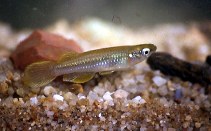| Family: |
Procatopodidae (African lampeyes), subfamily: Procatopodinae |
| Max. size: |
8.5 cm TL (male/unsexed) |
| Environment: |
benthopelagic; freshwater; pH range: 6.5 - 7.19999980926514, non-migratory |
| Distribution: |
Africa: widely distributed in southern Africa; present in various lakes and river drainages in Malawi, Tanzania, Mozambique, Zambia, Angola, Namibia, Botswana, Zimbabwe, South Africa and southeastern Democratic Republic of the Congo (Ref. 47311, 52193). |
| Diagnosis: |
Dorsal spines (total): 0-0; Dorsal soft rays (total): 6-8; Anal spines: 0-0; Anal soft rays: 11-14. Description: Body slender, elongated; caudal peduncle length more than twice its depth (Ref. 52193). Dorsal fin with 6-8 rays; anal fin with 11-14 rays; dorsal fin over posterior anal rays; caudal fin truncate or semi-truncate (Ref. 52193). Scales in lateral series 27-29 (Ref. 52193). Colouration: Males more colourful than females; colour translucent yellowish green with light silvery blue iridescence on body scales, sometimes an iridescent blue patch on upper half of gill cover; iris of eye silvery blue; fins clear in females, or yellow with dark yellow spots on the membrane in males; thin black edge to dorsal, caudal and anal fins (Ref. 52193). |
| Biology: |
Found near the surface and among weeds in which it seeks refuge and food (Ref. 5595). Prefers standing or gently flowing water as in river backwaters, floodplains (Ref. 7248), swamps (Ref. 7248, 47311), creeks and pools (Ref. 47311). Usually found in small shoals near the surface, among fringing vegetation; usually abundant when present (Ref. 47311, 52193). It feeds on small invertebrates like mosquito larvae and daphnia (Ref. 52193). A serial spawner, laying eggs which attach to vegetation (Ref. 52193). When food is abundant, breeding occurs daily over an extended period (year-round where conditions are suitable) (Ref. 7248, 52193). 6 cm max TL (Ref. 3788). Not a seasonal killifish. Is difficult to maintain in aquarium (Ref. 27139). |
| IUCN Red List Status: |
Least Concern (LC); Date assessed: 13 November 2017 Ref. (130435)
|
| Threat to humans: |
harmless |
Source and more info: www.fishbase.org. For personal, classroom, and other internal use only. Not for publication.

